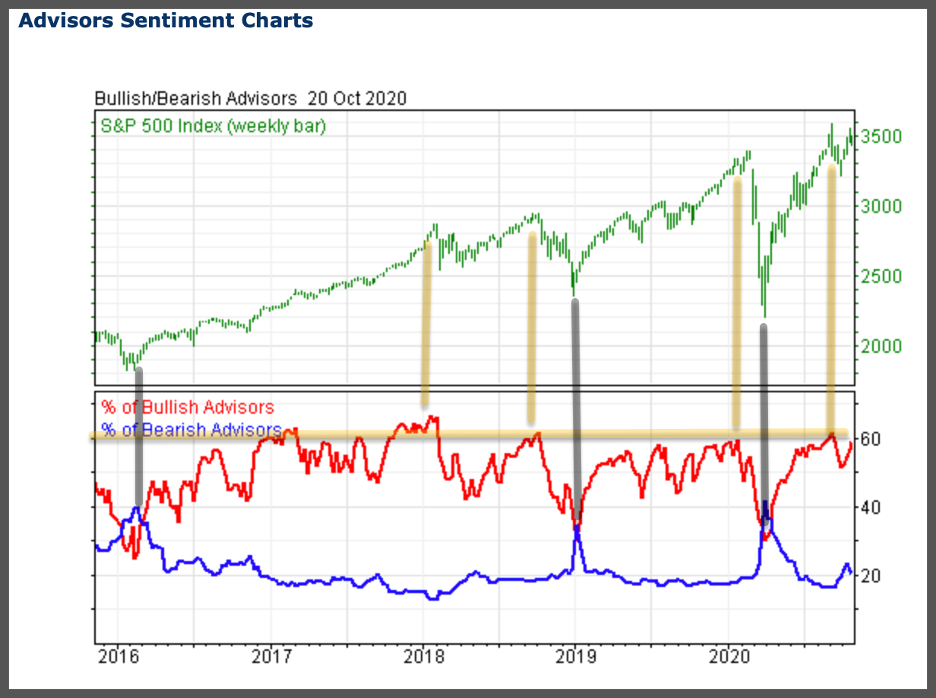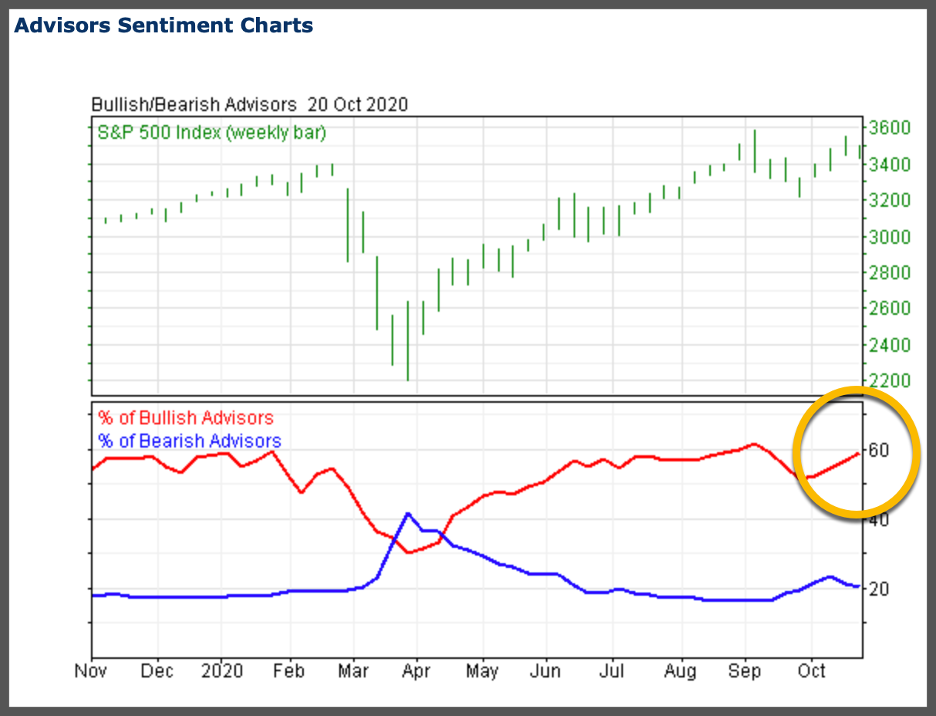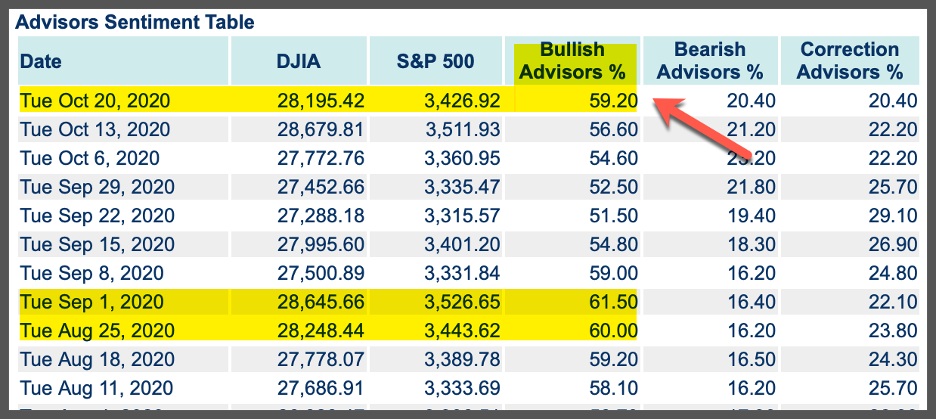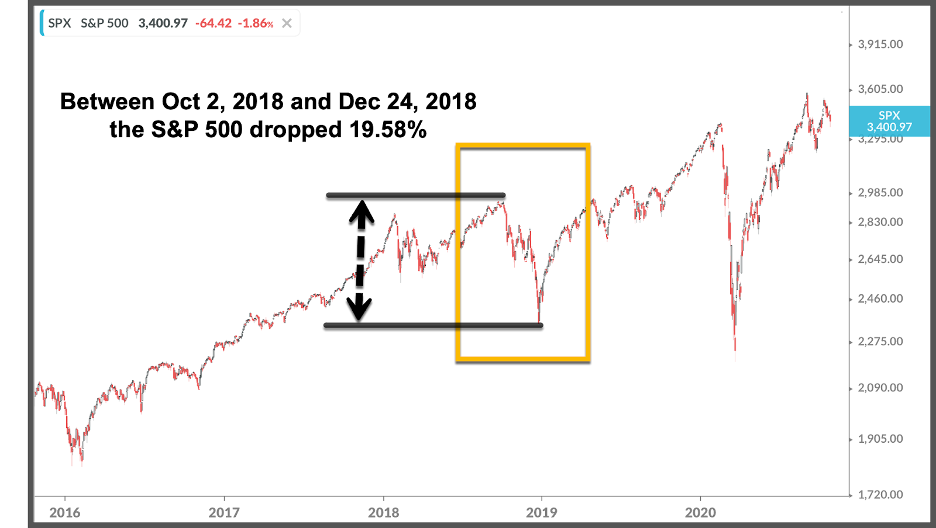Related Blogs
October 28, 2020 | Michael Reilly
 Last week, the Investment Advisors Sentiment Indicator hit its highest level since peaking in August, just prior to September’s selloff.
Last week, the Investment Advisors Sentiment Indicator hit its highest level since peaking in August, just prior to September’s selloff.
Is it now foreshadowing the next big pullback?
Every week, Investors Intelligence surveys over a hundred independent market newsletters and assess each contributor’s current stance on the market: Bullish, Bearish or Correction.
The survey has come to be considered a contrarian indicator – meaning when there is either too much bullishness or too much bearishness in the market, we are likely close to a key turning point.
You see, back in 1963, when the survey was first developed by AW Cohen, he originally expected that the best time to be invested in stocks was when most advisors were bullish.
That makes sense. After all, if so many professional writers/advisors were all bullish, shouldn’t the rest of us follow their lead?
Well, Cohen’s thesis proved to be wrong – a majority of advisors and commentators were almost always wrong at market turning points (Tops or Bottoms). Quite simply, professional advisors are just as susceptible to market emotions as individual investors – they become far too greedy at the top of trends and far too fearful near the bottom.
And that is why we find the survey best used as a contrarian indicator.
More often than not, sentiment readings remain neutral. We consider the norm to be 45% bulls, 35% bears and 20% neutral. When sentiment indicators are in these ranges they don’t provide much value.
However, when readings are at extremes, it’s wise to pay close attention.
Take a good look at the sentiment chart below. I’ve highlighted areas during the previous 5 years when sentiment was excessively bullish – with readings at 60 or above and areas where market sentiment was excessively bearish – with readings of 30 or below…
The yellow vertical lines correspond to the high readings and have all been followed by significant market pullbacks.

While the darker vertical lines correspond to market bottoms, followed by strong market rebounds.
We could say, advisors are only wrong when too many of them start thinking the same thing!
Which brings me to today…
As of last Tuesday’s survey (Oct 20), we again find ourselves at extreme bullishness – with the sentiment indicator at an extreme reading of nearly 60%. Remember, 45% bulls are more normal – or not extreme.

Here’s the same information presented in a different format.

The number of bullish Advisors jumped to 59.2%, from 56.6% the week before.. Meaning Tuesday’s reading is only slightly lower than the peak of September 1, 2020 – prior to the markets most recent pullback.
And that was the most bullishness in two years, when in Sept-2018 the reading hit 61.8% – that extreme bullish reading preceded the October to December sell-off that saw the market tumble nearly 20%.

So what should investors do? Well, the rule is anything above 55% Bulls, calls for some defensive measures – tighten stops, hedge your accounts using protective puts or consider selling shares with big gains. Bullishness at 60% or higher is a signal of increased risk the higher they get, and the need to prepare for a potential market decline.
To be sure, the survey is a leading indicator, but it’s not a crystal ball.
Sentiment topping signals can take months before markets decline. Nonetheless, investors will want to be aware of sentiment indicators and apply them to their specific investment time horizon.
My advice, make sure you’re applying the right tool to the right time horizon. Long-term investors, those who plan to remain invested regardless of headlines and short term market volatility may choose to ignore the survey results altogether, while short-term traders are more likely heed the warning signs and take steps to protect profits. So, to thy own self be true…. Understand who you are as an investor and proceed accordingly.
That’s all from here today. Until next week, invest wisely.
Tags

Get Our FREE Guide
How to Find the Best Advisor for You
Learn how to choose an advisor that has your best interests in mind. You'll also be subscribed to ADAPT, Avalon’s free newsletter with updates on our strongest performing investment models and market insights from a responsible money management perspective.

